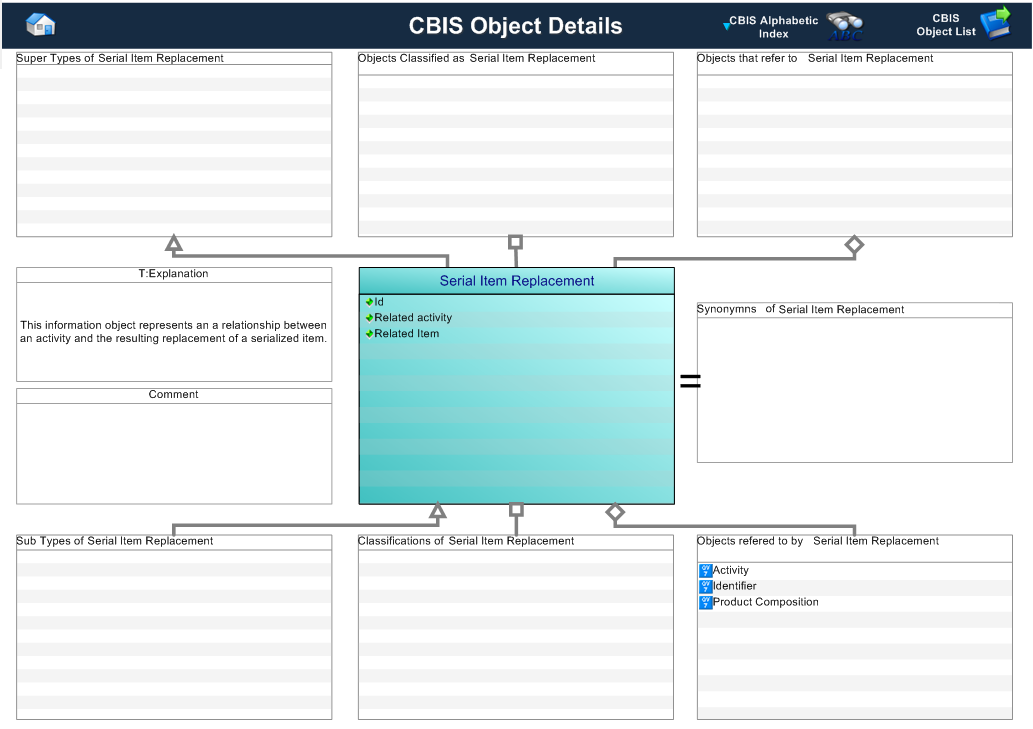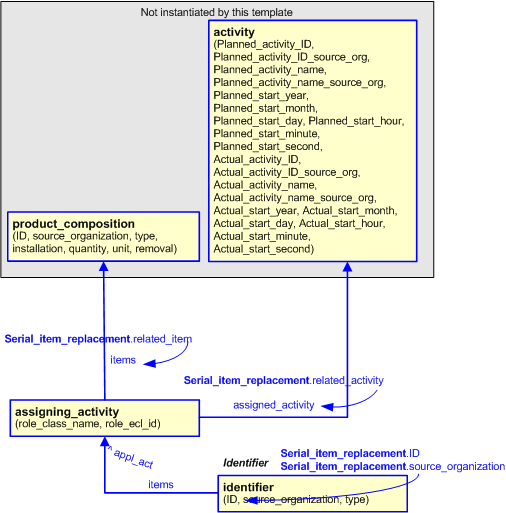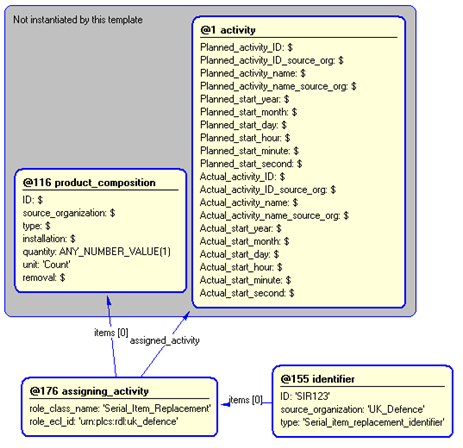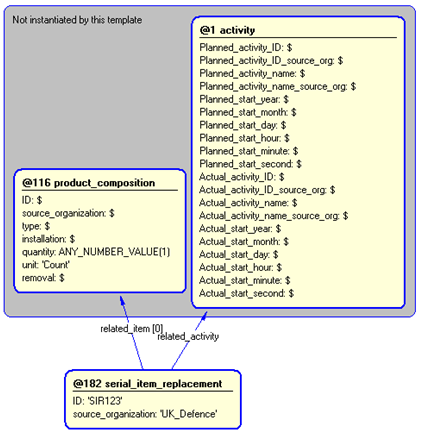Template:— serial_item_replacement (srl_itm_rplcmnt)
Context:— UK_Defence |
Date: 2009/04/17 11:50:21
Revision: 1.3
|
This section specifies the template serial_item_replacement.
NOTE
The template has been defined in the context of
UK_Defence.
Refer to the business context for details of related templates.
NOTE
An explanation of a template and the associated instantiation path is
provided in the
Template overview
section.
This template describes how to represent the relationship between an activity and the resulting
replacement of a serialized item.
The role change business object is used by those UK_Defence Data Exchange
Specifications that require information about the relationship between an activity and the
resulting replacement of a serialized item.
Figure 1 — Graphical Representation for Business Object Serial Item Replacement
Serial Item Replacement:
The definition of a Serial Item Replacement object is:
Data about the relationship between an activity and the
resulting replacement of a serialized item.
|
Attribute name
|
Attribute description
|
Attribute type
|
Optionality
|
| ID |
This is the identifier of the item replacement relationship |
Identifier |
Mandatory |
| Related_activity |
This is a reference to the related Activity. |
Relationship to Activity |
Mandatory |
| Related Item |
This is a reference to the related item replacement in the product composition. |
Relationship to Product_Composition |
Mandatory |
Table 1 — Serial Item Replacement attribute details
The EXPRESS-G diagram in
Figure
2
shows the templates and EXPRESS entities that are required
to represent the template
"serial_item_replacement".
The text highlighted in blue shows the template parameters.
Figure 2 — An EXPRESS-G representation of the Information model for serial_item_replacement
The graphic for the template to be used in other EXPRESS-G diagrams
is shown in Figure
3
below.
Figure 3 — The graphical representation of the serial_item_replacement template
The following input parameters are defined for this template:
This is the identifier of the item replacement relationship.
The organization that created the identifier. Additionally
a Person or Information System could be defined when either of these are the source; see Identifier template.
This is a reference to the related Activity
This is a reference to the related item replacement in the product composition.
The following reference parameters are defined for this template:
%^target = $serial_item_replacement.serial_item_replace%
The following parameter combinations specify a uniqueness constraint:
Unique constraint: Serial_Item_Replacement
Each instance of the
entity
(
Applied_activity_assignment)
within the data set shall be uniquely identified
by the following parameters on this
template (serial_item_replacement) namely:
ID.
The
instance is
referenced by the following template parameter:
serial_item_replace.
The instantiation path shown below specifies the entities that are to be
instantiated by the template.
A description of templates and the syntax for the instantiation path is
provided in the
Templates Help/Information section.
-- assigning_activity /
assigning_activity(
role_class_name='Serial_Item_Replacement',
role_ecl_id='urn:plcs:rdl:uk_defence',
assigned_activity=@related_activity,
items=@related_item)/
%^serial_item_replace = $assigning_activity.appl_act%
-- ID (mandatory) /
identifier(
ID=@ID,
source_organization=@source_organization,
type='Serial_item_replacement_identifier',
items=^serial_item_replace)/
The instance diagram in Figure
4
shows an example of the EXPRESS entities and templates that are instantiated by the template:
/serial_item_replacement(ID='SIR123', source_organization='UK_Defence', related_activity='@1', related_item='@116')/
(an illustration of the consolidated serial_item_replacement template is shown in
Figure
5 below.)
Figure 4 — Entities instantiated by serial_item_replacement template
The instance diagram in
Figure
5
shows the graphic symbol for the template that is to be
used in other instance diagrams. The example template is:
/serial_item_replacement(ID='SIR123', source_organization='UK_Defence', related_activity='@1', related_item='@116')/
Figure 5 — Instantiation of serial_item_replacement template
Characterizations
No common characterizations of the template
serial_item_replacement
have been identified. However, the ISO 10303-239 EXPRESS model
may enable other assignments to the entities instantiated by the template.




